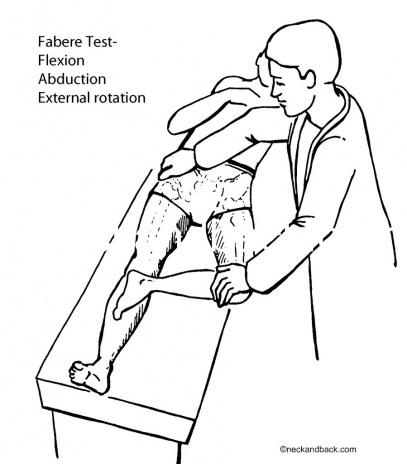Definition/Description
The FABER (Patrick’s) Test stands for: Flexion, Abduction and External Rotation. These three movements combined result in a clinical pain provocation test to assist in diagnosis of pathologies at the hip, lumbar and sacroiliac region. [1]
Clinically Relevant Anatomy
Hip articulation is true diarthroidal ball and-socket style joint.
Formed from the head of the femur as it articulates with the acetabulum of the pelvis. This joint serves as the main connection between the lower extremity and the trunk, and typically works in a closed kinematic chain.[2] Thus is designed for stability and weight-bearing – rather than a large range of movement.
Movements available at the hip joint are flexion, extension, abduction, adduction, internal rotation and external rotation. The ligaments of the hip joint act to increase stability. They can be divided into two groups – intracapsular and extracapsular.
For more detailed information on the anatomy of the hip, lumbar spine and sacroiliac joint.
Purpose
The FABER test is used to identify the presence of hip pathology by attempting to reproduce pain in the hip, lumbar spine or sacroiliac region. The test is a passive screening tool for musculoskeletal pathologies, such as hip, lumbar spine, or sacroiliac joint dysfunction, or an iliopsoas spasm.[3][1]
The test also assesses the hip, due to forces being transferred through the joint. The position of flexion, abduction, and external rotation, when combined with overpressure, stresses the femoral-acetabular joint and produces pain, if irritated.[4][5]
In conjunction with other tests such as range of movement and hip quadrant test, FABERs can be a useful tool to guide practitioners when to refer for further imaging in patients with persistent hip or groin pain.[6]
When the FABER test is clustered, it can provide highly useful information in identifying those suffering from sacroiliac joint dysfunction. This tests the sacroiliac joint, as the horizontal abduction force goes through the femur, the soft tissues under tension transfer the forces to the sacroiliac joint. Hence, this test can indicate pathology located in the hip or sacroiliac joint.
Technique
The patient is positioned in supine. The leg is placed in a figure-4 position (hip flexed and abducted with the lateral ankle resting on the contralateral thigh proximal to the knee. [7] While stabilizing the opposite side of the pelvis at the anterior superior iliac spine, an external rotation, abduction and posterior force is then lightly applied to the ipsilateral knee until the end range of motion is achieved. A further few small-amplitude oscillations can be applied to check for pain provocation at the end range of motion. [8] A positive test is one that reproduces the patient’s pain or limits their range of movement. [7]
Interpretation
The following findings of a positive FABER test may help to guide your clinical diagnosis;
- Sarcoiliac Joint Pain on external hip rotation
- Groin Pain on external hip rotation
- Posterior Hip Pain on external hip rotation
- Posterior Hip Impingement
Evidence
- Reliability: FABER measured with a ruler, normalized FABER range of movement, and inclinometry all resulted in excellent intra-rater reliability, with the highest ICC being demonstrated for inclinometry (ICC 0.86, 0.86, and 0.91).[10] The use of an inclinometer may increase reliability when performed by an experienced clinician in comparison with height measutements.
- Sensitivity for identification of hip pathology identified with arthroscopy: 0.89[6]
- Correlation of positive test with OA on radiographs: r = 0.54[9]
- Kappa (95% Confidence interval): 0.63 (0.43-0.83), Kappa Maximum: 0.83, Percent agreement: 84%, Prevalence: 0.37, Bias: 0.07[1]
- Diagnostic value of FABER test compared to MR arthrogra¬phy in labral tear diagnostics: sensitivety: 41%, specificity: 100%, positive predictive value: 100%, negative predictive value: 9%[8]
- The validity and reliability of the FABER test is very contradictory, some say it is an invalid and unreliable test[11] , while others disagree about the outcome and feel physical diagnostic tests do not have enough quality evidence to support the use of them for diagnosis purposes.[12][13]
Clinical Relevance
The FABER test can be used in assessment of the hip, sacroiliac joint or lumbar spine as a pain provocation test alongside quality subject assessment and basic objective assessment.
The FABER test is quick to perform and can give a measure of range of movement as well as being a pain provocation test, although it may not give a clear diagnosis it may assist the user in clinically reasoning which further tests or exercises to perform.
The evidence supporting this test is varied and more studies are required to fully assess the value of this and other hip pathology tests[14]. Although more evidence is becoming apparent that physical tests are less reliable and subject to user error. [12]
References
- ↑ 1.01.11.2 Martin RL, Sekiya JK. ↑ Hip Anatomy. (2017, June 6). Physiopedia, . Retrieved 10:17, December 14, 2017 from ↑ Dutton M. Orthopaedic: Examination, evaluation, and intervention. 2nd ed. New York: The McGraw-Hill Companies, Inc; 2008.
- ↑ Broadhurst NA, Bond MJ. ↑ Philippon MJ, Stubbs AJ, Schenker ML, Maxwell RB, Ganz R, Leunig M. ↑ 6.06.1 B, McCroy P, Brukner P, et al. ↑ 7.07.1 Flynn T, Cleland J, Whitman J. User’s guide to the musculoskeletal examination: Fundamentals for the evidence-based clinician. Buckner, Kentucky: Evidence in Motion; 2008
- ↑ 8.08.18.2 Troelsen A, Mechlenburg I, Gelineck J, Bolvig L, Jacobsen S, Søballe K. ↑ 9.09.1 Theiler R, Stucki G, Schotz R, Hofer H, Seifert B. ↑ Bagwell JJ, Bauer L, Gradoz M, Grindstaff TL. ↑ Cattley P, Winyard J, Trevaskis J, Eaton S. ↑ 12.012.1 Tijssen M, van Cingel R, Willemsen L, de Visser E. ↑ Vleeming A, Albert HB, Ostgaard HC, Sturesson B, Stuge B.↑ Reiman MP, Goode AP, Hegedus EJ, Cook CE, Wright AA. function gtElInit() { var lib = new google.translate.TranslateService(); lib.setCheckVisibility(false); lib.translatePage('en', 'pt', function (progress, done, error) { if (progress == 100 || done || error) { document.getElementById("gt-dt-spinner").style.display = "none"; } }); }

